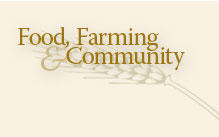The Food Footprint
Session 3
Summary
Where does our food come from, and why does this matter? In this session, learners examine materials and energy used in food production as well as the wastes produced. As learners explore the environmental impacts of these processes, they gain an understanding of the food “footprint.”
Guiding Questions
- What are different ways to organize a food system and what are the similarities and differences in terms of approaches and outcomes?
- What are key trends in food production and consumption and what do these tell us about our food system?
Big Ideas
- Inputs and outputs of food systems contribute to and are results of the production of food products. Inputs and outputs have environmental impacts—some positive and nourishing, others are negative. Together, the negative environmental impacts are called a “footprint.” The greater a food’s negative environmental impact, the bigger its “footprint.” Foods that require a lot of fossil fuels and produce polluting waste (rather than nourishing outputs) have a bigger footprint. The environment serves as the source of all inputs and materials, and the “sink” into which all wastes (outputs) go.
- Actions associated with harvesting inputs and disposing of outputs have environmental impacts, some positive, some negative. Examples:
- Clearing land for food production can mean deforestation.
- Actions associated with removing some inputs from the environment (such as drilling for oil or harvesting trees) have negative environment consequences.
- Burning fossil fuels creates outputs (emissions) that are accumulating in the atmosphere faster than can be absorbed by natural carbon sequestration systems. This creates negative environmental impacts.
- Some outputs (such food scraps) can be nourishing if they are re-used in ways that benefit the environment (i.e., if food scraps become compost).
Session 3 Materials:
- Facilitator Guide (PDF/5 pgs)
- Learner packet (PDF/17 pgs)
- PowerPoint slides (PPT)




